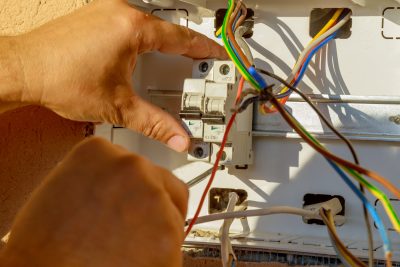1. Key Takeaways
2. What Is a Circuit Breaker?
3. Types of Circuit Breakers
4. Choosing the Right Circuit Breaker
5. Core Components and Mechanisms
6. Installation and Maintenance Best Practices
7. Troubleshooting Common Issues
8. Safety Standards and Certifications
9. Making Sense of Circuit Breakers: Why They Matter for Your Home or Business
Circuit breakers are essential components of every safe and functional electrical system. When a fault develops, they automatically turn off the electricity, preventing overheating, fire dangers, and equipment damage. These devices are critical for protecting homes, businesses, and industrial facilities.
Turnkey Electricals presents The Ultimate Guide to Circuit Breakers, which simplifies how they function, why they matter, and how to select, install, and maintain them for dependable protection. If you’re ready to make your electrical system safer and more reliable, let’s explore your options together. Get in touch with us to start protecting your home or business today.

A circuit breaker is a safety device that cuts power when something goes wrong. Before things become worse, it is intended to identify dangerous situations like short circuits and overcurrents and then “trip” to cut off electricity.
When electrical current reaches unsafe thresholds, an automatic safety mechanism called a circuit breaker cuts it off. It shields equipment, people, and property against malfunctions, short circuits, and overloads. Breakers are more convenient and affordable than fuses, which need to be changed after a journey.
Each circuit breaker has parts that work together to protect your system. The trip unit detects unsafe currents and triggers a mechanism to open the contacts and stop the flow. If an arc forms, the arc extinguishing system safely handles it using air, vacuum, or gas, depending on the breaker type.
Circuit breakers protect not only appliances but also people’s lives. They stop the flow of surplus current, preventing fires and reducing the risk of electrocution. Residential regions normally use miniature circuit breakers (MCBs), whereas commercial and industrial settings use molded case circuit breakers (MCCBs) for heavier loads.
Circuit breakers come in thermal, magnetic, hybrid, and smart types. Each offers protection, from basic overload response to smart home features with remote control and energy tracking.
These rely on a heat-sensitive bimetallic strip that bends and trips the circuit when exposed to excessive current. They work best under gradual overload and are commonly utilized in home settings.
These use electromagnetic force to trip quickly during a sudden overcurrent. They’re ideal for industrial applications or places needing instant protection from surges.
Hybrid breakers combine thermal and magnetic systems to handle both slow overloads and sudden spikes. They work well in homes, businesses, and other settings.
Smart breakers include remote control, energy monitoring, and mobile app notifications. They are commonly utilized in smart homes and energy-saving structures, notably in cities such as New Orleans, when integrated with IoT networks.
Choosing the right breaker is a matter of considering load, application, and safety codes. Residential houses usually use single- or double-pole breakers, but commercial settings can necessitate complex types like vacuum circuit breakers or ground fault interrupters as extra protection.
Circuit breakers are protective devices that safeguard electrical systems against overcurrent damage or short circuits. Incredibly, their operation depends upon a carefully balanced mix of specialized internal parts and mechanisms.
The standard breaker includes a supporting frame, an operating mechanism to close and open circuits, contacts for current flow, a sensing trip unit, and an arc extinguishing system for safe disconnection.
Modern circuit breakers feature durable materials like copper (for conductivity) and reinforced polymers (for insulation). These materials help ensure long-lasting performance under demanding conditions.
New designs include fast-reclosing springs and advanced arc suppression with SF6 gas or magnetic coils. These features help breakers last longer and work better under stress.

Choose the right amp rating for your panel. Newer homes usually have 200-amp panels; older homes may need adjustments to handle modern loads.
Choose the right amp rating for your panel. Newer homes usually have 200-amp panels; older homes may need adjustments to handle modern loads.
Check breakers yearly for wear, rust, or loose connections. Frequent trips may mean overloaded circuits or old parts. Regular care can help breakers last 30 years or more.
Incorrect breaker sizing and sloppy wiring are common problems. Compliance with professional inspection at installation and with local codes eliminates long-term risk.
Even with quality equipment, problems can arise. The following are typical issues explored in The Ultimate Guide to Circuit Breakers.
This often results from overloading, short circuits, or faulty wiring. Older homes with outdated panels or aluminum wiring, common before the 1980s, are especially prone to these problems.
Note what devices ran during a trip. High-wattage items like air conditioners in New Orleans summers often overload circuits. Spread these loads across circuits to ease stress.
Disconnect extra devices or replace your electrical panel if there is not enough capacity. Make sure circuits are not carrying more power than they’re supposed to.
Recurring problems such as flickering lights, burning odors, or frequent returns are indicators that the services of a professional are required. Trained electricians can examine, detect, and repair underlying issues while maintaining adherence to safety standards.
UL, IEC, and ANSI safety standards are necessary for circuit breakers to function properly under stress. These certifications guarantee quality, performance, and protection. Compliance with the National Electrical Code (NEC) is necessary for installations in the U.S. to prevent potential violations and hazards from occurring.
Circuit breakers do more than prevent overloads—they help protect what matters most. Knowing how they work gives you more control and peace of mind.
If you’re planning electrical changes or need help with installation, let us handle it. Our team at Turnkey Electricals is here to make things safer, simpler, and done right the first time. Contact us today to get started with expert support you can trust.